Flash floods across northern Pakistan and India-controlled Kashmir have killed at least 344 people in the past 48 hours, local authorities said on Saturday.
Most of the deaths, 328, were reported in the mountains of Khyber Pakhtunkhwa, in northwestern Pakistan, according to the Provincial Disaster Management Authority.
Eleven more people were killed in Kashmir, while five died in the northern Gilgit-Baltistan region.
Another five people, including two pilots, were killed when a local government helicopter crashed as a result of the bad weather during a relief mission on Friday.
Rescuers began a third day of scouring Khyber Pakhtunkhwa on Saturday, while others looked for missing people in the Kishtwar district of Kashmir.
Mass funerals were held in the Buner district, one of the worst-hit areas, where 184 people were reported dead by local officials.
The majority were killed in flash floods or when houses collapsed, while at least 120 others have been injured.
One eyewitness, who escaped the deluges in Buner, described seeing floodwaters carrying hundreds of boulders and ‘tons of rocks’ crashing down.
Hundreds of rescue workers are still searching for survivors in Buner, one of several places where torrential rains and cloudbursts caused massive flooding on Friday, said Mohammad Suhail, a spokesman for the emergency services.
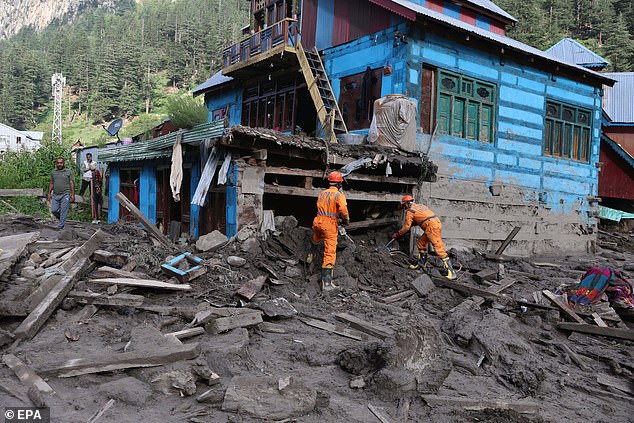
Flash floods across northern Pakistan and India-controlled Kashmir have killed at least 344 people in the past 48 hours, local authorities said on Saturday. Pictured: National Disaster Response Force (NDRF) members search for missing people in the cloudburst-hit village of Chisoti
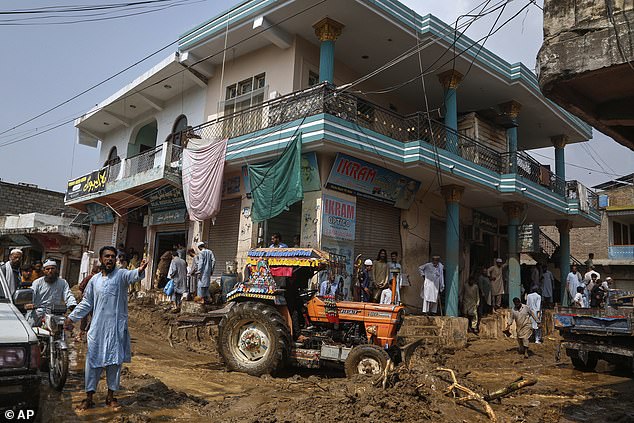
Most of the deaths, 328, were reported in the mountains of Khyber Pakhtunkhwa in northwestern Pakistan, according to the Provincial Disaster Management Authority. Pictured: Local residents clear the debris and mud from their shops after Friday’s flash flooding on the outskirts of Pir Baba, Buner district
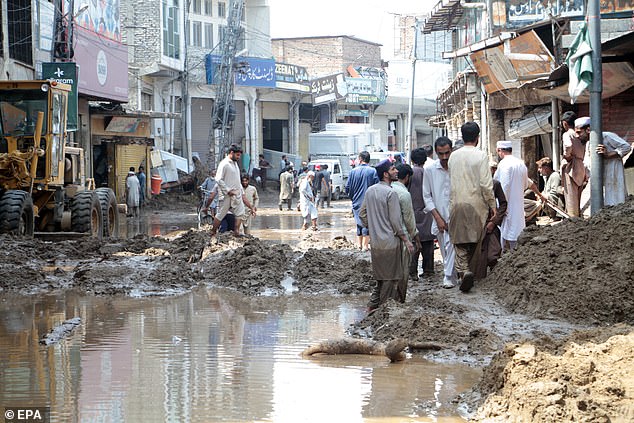
People survey damage caused by flash floods in Swat, Pakistan, 16 August 2025
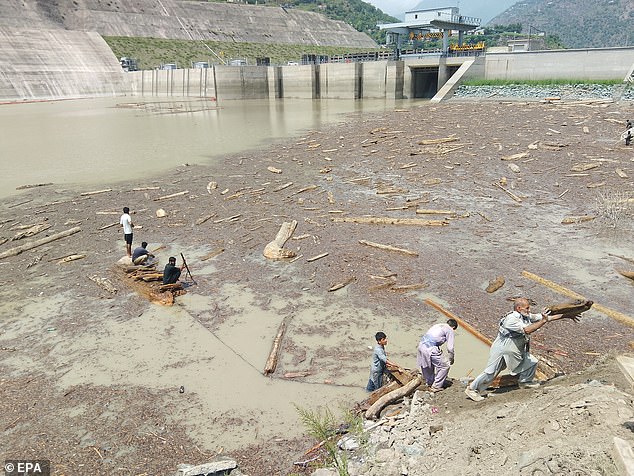
People collect logs from Neelum-Jhelum dam after recent floods, in Neelum valley, Pakistani administered Kashmir, 16 August 2025
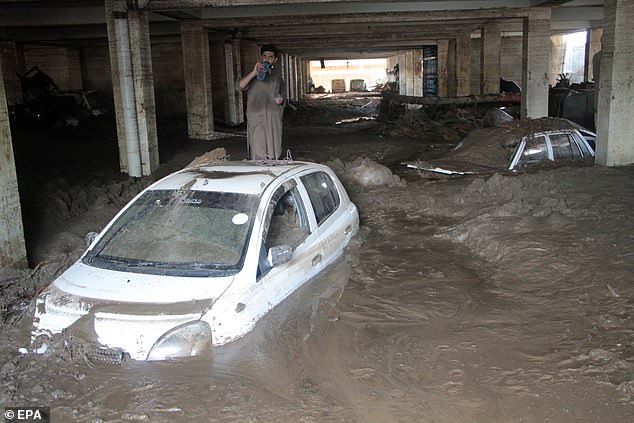
Vehicles trapped in mud in the aftermath of flash floods in Swat, Pakistan, 16 August 2025
Dozens of homes were swept away. First responders have been trying to recover bodies from the worst-hit villages of Pir Baba and Malik Pura, where most of the fatalities were, said Kashif Qayyum, a deputy commissioner in Buner.
Local police officer Imtiaz Khan, who narrowly escaped the deluges, said floodwaters carrying hundreds of boulders struck and flattened homes within minutes.
‘A stream near Pir Baba village in Buner swelled without warning.
‘At first, we thought it was a normal flash flood, but when tons of rocks came crashing down with the water, 60 to 70 houses were swept away in moments,’ Khan told The Associated Press, adding that many bodies were left mutilated.
‘Our police station was washed away too and if we hadn’t climbed to higher ground, we would not have survived,’ Khan said.
Pakistan’s Meteorological Department predicted torrential rains in the coming days and warned that monsoon activity was likely to intensify from Sunday onwards, including in the north and northwest.
Rescuers said they saw large swathes of Pir Baba village destroyed, wrecked homes, and giant rocks filling the streets as the water started to recede.
‘It was not just the floodwater, it was a flood of boulders as well, which we saw for the first time in our lives,’ said Sultan Syed, 45, who suffered a broken arm.
Mohammad Khan, 53, said the floods ‘came so fast that many could not leave their homes.’
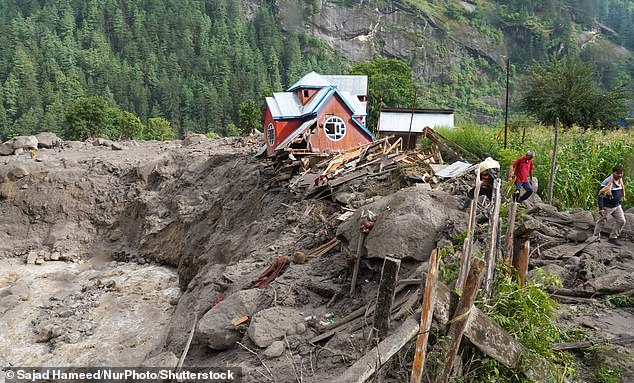
Damaged houses are pictured at the site of a flash flood in a mountain village in the Himalaya region of Kishtwar district, on august 15, 2025
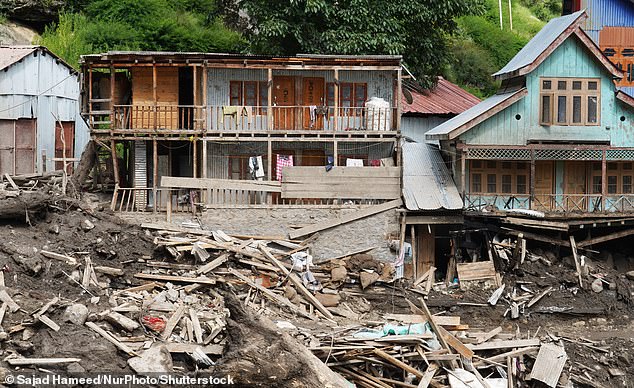
Damaged houses are pictured at the site of a flash flood in a mountain village in the Himalaya region of Kishtwar district, on august 15, 2025
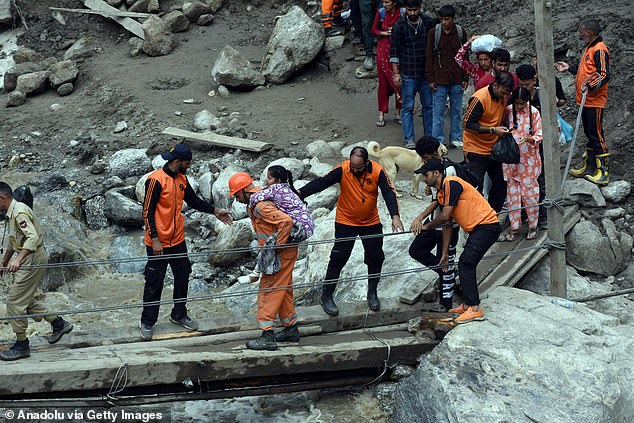
A girl is being rescued near the site of cloudburst in Chositi village in Indian-administered Kishtwar, Jammu and Kashmir on August 15
Most victims died before reaching the hospital, said Mohammad Tariq, a doctor in Buner.
‘Many among the dead were children and men, while women were away in the hills collecting firewood and grazing cattle.’
Pakistani leaders, including the prime minister and president, offered their condolences to the families of the dead and said they were praying for the speedy recovery of the injured.
The chief minister of Khyber Pakhtunkhwa, Ali Amin Gandapur, said efforts were underway to repair roads and other damaged infrastructure.
Pakistan has received higher-than-normal monsoon rainfall this year, which experts link to climate change, triggering floods and mudslides that have killed some 541 people since June 26, according to the National Disaster Management Authority.
Mourners attended mass funerals on Saturday, while authorities supplied tents and food to people in Buner.
Local cleric Mufti Fazal had led funeral prayers at multiple locations since Friday morning. ‘Before yesterday’s floods, the area was bustling with life. Now, there is grief and sorrow everywhere.’
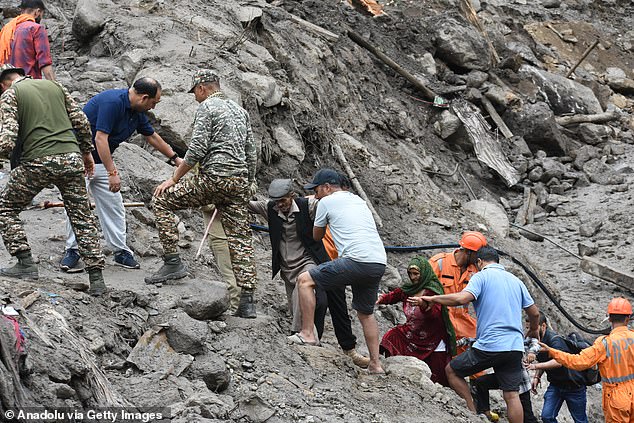
Police, Indian Army, NDRF and State Disaster Response Forces rescue and evacuate people near the site of cloudburst in Chositi village in Indian-administered Kishtwar, Jammu and Kashmir on August 15
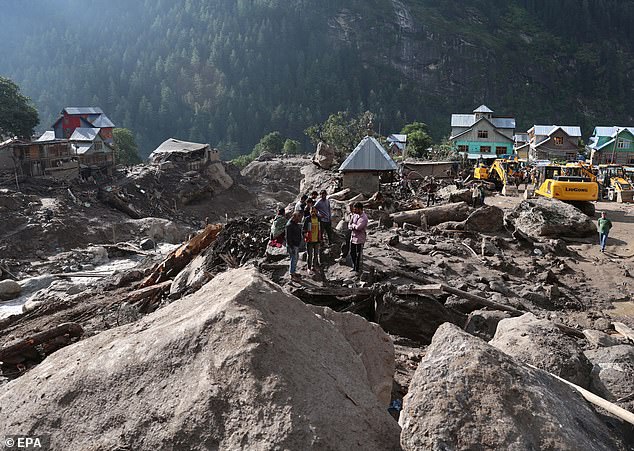
Emergency teams work in the cloudburst-hit village of Chisoti, in the Kishtwar district of Jammu and Kashmir, India, 16
Schoolteacher Suleman Khan lost 25 members of his extended family. He and his brother survived only because they were away from home when the floods hit his village Qadar Nagar.
In Pir Baba, mourners laid out the covered bodies of their loved ones on wooden bedframes or bore them aloft ahead of burials. In a hospital, paramedics placed blocks of ice next to the deceased or comforted the injured.
According to the provincial disaster management authority, at least 351 people have died in rain-related incidents this week across Khyber Pakhtunkhwa and the northern region of Gilgit-Baltistan.
In India-controlled Kashmir, rescuers scoured the remote village of Chositi in the district of Kishtwar on Saturday, looking for dozens of missing people after it was hit by flash floods two days earlier, killing 60 and injuring some 150, about 50 in critical condition.
Thursday’s floods struck during an annual Hindu pilgrimage in the area. Authorities have rescued over 300 people, while some 4,000 pilgrims have been evacuated to safety.
Such cloudbursts are increasingly common in India’s Himalayan regions and Pakistan’s northern areas, and experts have said climate change is a contributing factor.
Pakistani officials said rescuers since Thursday have evacuated more than 3,500 tourists trapped in flood-hit areas across the country.
Many travelers have ignored government warnings about avoiding vulnerable regions in the north and northwest.
Pakistan witnessed its worst-ever monsoon season in 2022. It killed more than 1,700 people and caused an estimated $40 billion in damage.